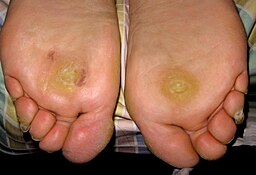Welcome, dear readers! Today we’re diving into a topic that’s both fascinating and vital to understand – skin growths and neoplasms. Your skin is an incredible organ, the largest in your body, with the vital job of protecting you from the outside world. But sometimes, things can go awry, resulting in various skin growths and neoplasms. While the words may sound a bit daunting, they’re simply terms used to describe changes in the skin that result in visible growths. So, sit tight as we take you on a journey of understanding these conditions better.
What are Skin Growths and Neoplasms?

Skin growths and neoplasms refer to any abnormal proliferation of cells in the skin, resulting in visible changes. These can range from harmless growths like moles or skin tags to serious conditions like skin cancer.
Neoplasms, in particular, are abnormal tissue masses caused by excessive cell growth and division. They can be benign (non-cancerous), premalignant (pre-cancerous), or malignant (cancerous). Understanding these differences is crucial as it helps dictate the course of treatment and provides insight into the condition’s potential to harm.
Common Types of Skin Growths
Let’s start by looking at some of the most common benign skin growths:
- Moles (Nevi): These are small skin markings caused by cells in the skin that produce pigment (melanocytes). Moles can be flat or raised and are usually brown or black.
- Skin Tags (Acrochordons): Small, soft pieces of skin that hang on by a thin stalk. These are common in areas where the skin folds, like the armpits, groin, and neck.
- Warts: Rough bumps on the skin caused by the human papillomavirus (HPV). They can appear anywhere but are most common on the hands and feet.
- Lipomas: These are soft, fatty lumps that grow under the skin, caused by an overgrowth of fat cells.
Common Types of Skin Neoplasms

Now, let’s explore some common skin neoplasms:
- Seborrheic Keratoses: These are usually brown, black, or light tan growths on the face, chest, shoulders, or back. They have a waxy, scaly, slightly elevated appearance.
- Dermoid Cysts: These neoplasms contain mature skin complete with hair follicles, sweat glands, and often clumps of long hair, as well as fat, bone, nails, teeth, eyes, cartilage, and thyroid tissue.
In the more serious realm, we have malignant skin neoplasms, better known as skin cancers:
- Basal Cell Carcinoma (BCC): The most common type of skin cancer. BCCs often look like open sores, red patches, pink growths, shiny bumps, or scars.
- Squamous Cell Carcinoma (SCC): This type of skin cancer often appears as a firm red nodule or a flat lesion with a scaly, crusted surface.
- Melanoma: The most dangerous form of skin cancer. These cancerous growths develop when unrepaired DNA damage to skin cells triggers mutations that lead the skin cells to multiply rapidly and form malignant tumors.
Causes and Risk Factors

Various factors contribute to the development of skin growth and neoplasms. Exposure to sunlight and its harmful ultraviolet (UV) rays is a significant risk factor, especially for skin cancers. These rays can cause damage to the DNA in skin cells, leading to abnormal growth and division.
Genetics also plays a crucial role. For example, your risk may be higher if you have a family history of certain skin conditions or skin cancer. Age is another factor, as the likelihood of developing skin growths and neoplasms increases over time due to cumulative exposure to UV rays and other damaging agents.
Skin type can also influence your risk. For instance, people with lighter skin have less melanin, the pigment that offers some UV protection. As a result, they’re more susceptible to skin growths and neoplasms, particularly malignant ones.
Symptoms and Diagnosis

Skin growths and neoplasms often present visible symptoms. However, these can vary widely depending on the type of growth or neoplasm. Common signs include new growths on the skin, changes in existing moles, and lesions that itch, bleed, or don’t heal.
If you notice any such changes, it’s important to consult a healthcare professional. They can perform a visual inspection and take a skin biopsy if necessary. A biopsy involves examining a small sample of the suspicious area under a microscope. In addition, imaging tests like CT scans, MRIs, or PET scans might be required for certain skin cancers to determine if the cancer has spread.
Treatment Options
Treatment for skin growth and neoplasms depends on the type, size, and location of the growth and the patient’s overall health.
Benign growths like moles, skin tags, or warts often don’t require treatment unless they’re causing discomfort or you’re unhappy with their appearance. In such cases, options can include excision (surgical removal), cryotherapy (freezing), or laser treatment.
For malignant neoplasms, treatment is crucial to prevent the cancer from spreading. This could involve surgical removal, radiation therapy, or chemotherapy. In some cases, targeted therapies or immunotherapies might be used.
Prevention and Care

While not all skin growths and neoplasms are preventable, there are steps you can take to care for your skin and reduce your risk:
- Sun Protection: Protect your skin from the sun’s harmful UV rays. This includes seeking shade when the sun is strongest, wearing protective clothing, and using broad-spectrum sunscreen with an SPF of at least 30.
- Skin Checks: Regularly check your skin for any new growths or changes in existing ones. Early detection is key to successful treatment, especially for skin cancer.
- Healthy Lifestyle: Maintain a healthy lifestyle. This includes a balanced diet, regular exercise, adequate sleep, and avoiding smoking and excessive alcohol.
Myths and Misconceptions
With skin conditions, there’s no shortage of myths and misconceptions. For instance, some believe that tanning booths are safe. The reality, however, is that they emit UV rays that can harm your skin and increase your risk of skin cancer. Another myth is that skin cancer isn’t serious. While it’s true that many skin cancers can be effectively treated if caught early, they can still be life-threatening, particularly melanoma.
FAQs

Can benign skin growths become cancerous?
While most benign skin growths do not become cancerous, some, like certain types of moles, can develop into skin cancer. Regular skin checks can help detect any changes early.
Does everyone get skin growth as they age?
While skin growths are more common as you age, they’re not inevitable. Good skincare habits can help reduce their occurrence.
Are skin growths contagious?
Most skin growths are not contagious. However, certain types, like warts, are caused by viruses and can be spread through direct contact.
Can skin neoplasms be prevented?

While not all skin neoplasms can be prevented, you can significantly reduce your risk by protecting your skin from the sun, avoiding tanning beds, and maintaining a healthy lifestyle.
Does a negative biopsy result mean I am free from skin cancer?
A negative biopsy result means no cancer was found in the examined sample. However, monitoring your skin for changes and having regular check-ups is essential, as skin cancer can develop at any time.
What does skin cancer look like?
Skin cancer can present in many ways. It could be a new, unusual growth or a change in an existing mole. Signs to look for include asymmetry, irregular borders, varied colors, a diameter larger than 6mm, or any size, shape, or color changes.
Conclusion
Understanding skin growth and neoplasms can seem daunting, but it’s essential to maintaining your overall health. Remember, your skin is a reflection of your inner health and well-being. So, take care of it! If you notice any changes, don’t hesitate to seek professional help. After all, it’s always better to be safe than sorry when it comes to your health.
References
- American Academy of Dermatology Association. “Skin Cancer.”
- American Cancer Society. “Skin Cancer.”
- National Cancer Institute. “Skin Cancer.”
- MedlinePlus. “Skin Conditions.”
- Healthline. “Skin Cancer: Symptoms, Types, and Treatment.”